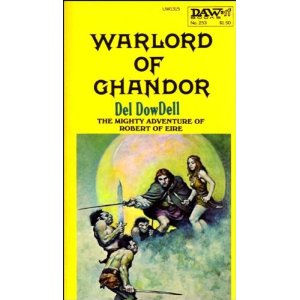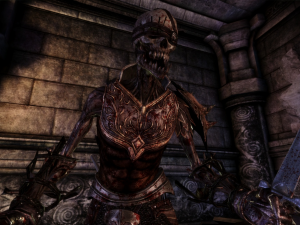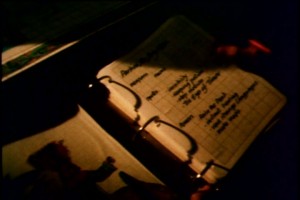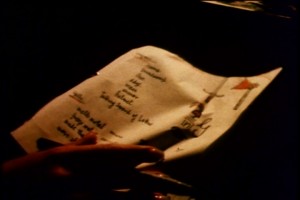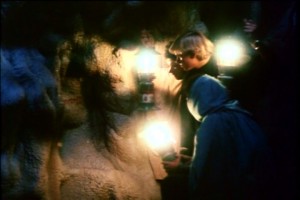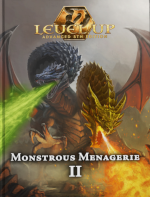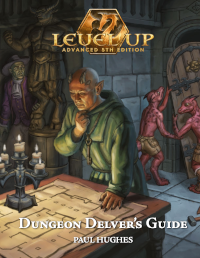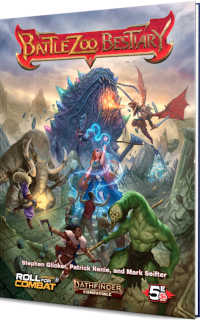Now that I have most of the Mazes and Monsters rules in some stage of completion, I decided it was time for a rules playtest.
The players assembled on a snowy Monday, ready to have their malleable minds molded or marred by the horrors of the Maze.
We watched a scene from Mazes and Monsters to get everyone psyched. Everyone seemed thrilled to be paying homage to this important film. Some of the players misunderstood and actually LAUGHED at it, like it was a comedy or something. Just a tribute to Tom Hanks’ irrepressible comic timing! He’s funny even when he’s not trying to be funny. That’s what made Philadelphia such a laugh riot.
One oversight we immediately noticed is that I didn’t bring the MOST IMPORTANT INGREDIENT, one thousand candles! We had to use stupid old light bulbs for illumination. I’ll have to remember to put a note to the Maze Controller somewhere prominent, like the back cover: “Maze Controller: Remember to bring candles!”
Character Creation
We ended up with a Fighter, a Holy Man, and two Frenetics. The lack of a rogue class was lamented. I know, right? If only there was some movie evidence of a rogue!
Based on the fact that Jay Jay’s frenetic was “the cleverest of all sprites”, the group decided that they could assign themselves fantasy races.
Character creation was very quick: after Hit Points were rolled, people just needed to roll for their Trait and Issue. One of the Frenetics rolled an 11 (a critical fumble) during Trait selection and got a negative trait: Bad Luck. The Good Luck trait lets you add a Trait die (essentially giving you a reroll) to one die roll per session. It wasn’t entirely clear what the opposite of that was, so I decided that it meant that once a session, the Maze Controller could demand a reroll of one of the player’s rolls and take the WORST of the two rolls. This led to an important rules doctrine for rolling a bad trait: “If it’s not clear what the opposite of a good trait is, the Maze Controller is encouraged to come up with the most annoying interpretation.”
Characters rolled Issues secretly, and jotted down their privatemost secrets on their character sheet, right under Hit Points.
Shopping worked pretty well. I had a list of gear and spells for sale, and people coordinated with each other to make sure the party had at least one rope, axe, awl, chisel, and basically one of everything that was for sale.
Introductions
As in the movie, the players each introduced their character in the most deadpan monotone possible. I’ll recreate the introductions as well as I can remember:
“I am Lothar the Frenetic. I am the toughest of all dwarves. My main power is a magical bag of fairy dust, which I may use to control my enemies and make them kill each other.”
“I am Wal-mart the Orcish Frenetic. I am very impulsive, and my bad luck will be my downfall.”
“I am Sansange, a Holy Man with excellent dental hygiene. I have many spells and powers by which I maintain that hygiene in myself and others for the glory of Marcia and Neville.”
“I am Sir Robert the Fighter. I wander the earth righting wrongs. I am irked by people who exhibit bad manners.”
Shall ye enter?
I described the maze as follows:
“You stand before the Tomb of the Twin Kings. It is said that the Twin Kings, one good, one evil, stand guard over a royal treasure. It is also rumored that mystical skeletons patrol the tomb’s winding passageways. Thus warned, shall ye enter?”
With one voice, the players cried, “AYE!” — which was a relief, let me tell you, because I didn’t have a backup plan for the evening.
The first room in the maze contained nothing but a book on a lectern.
I had explained to the players that, in Mazes and Monsters, traps were extraordinarily deadly, but the Maze Controller was required to note that any trap “could be a trap”. In other words, if you’re not warned that something is a trap, it isn’t a trap. The players, though, were taking no chances. They turned pages with the tips of their swords and finally pushed the book into a sack via a carefully-described remote-control Rube Goldberg maneuver. Clearly, 1st edition D&D had scarred my players’ psyches. They were in luck, because shit was about to get PSYCHODRAMATIC.
After ascertaining that the book was not trapped, the players wanted to know what it said. It turned out that every page had a single nonsense sentence, in the form
A man holds two doves
A goat jumps two valleys
A Holy Man blesses two beggars
A candle holds two flames.
Etc.
Etc. was not actually enough for the players, though. They kept turning pages and asking me what else they read. I came up with
A trap takes two lives
A wolf eats two sheep
A coin has two sides
all the while hoping they would not keep on turning pages and come up with HUNDREDS MORE SENTENCES, which it looked like they were planning to do. Luckily they finally ran out of interest before they finished the whole book.
The player running the Holy Man reported that she had sort of forgotten I had to make up all these sentences; she thought she was reading a real book. The lines of fantasy and reality? Successfully crossed! The rest of this playtest would be spent in the liminal realm between sanity and madness.
The next room had three doors, each opened by a pressure plate on a mysterious altar. The players correctly decided, based on the ample evidence provided by the book, that the number 2 was important in this dungeon, and chose to open Door Number 2. This was too bad, because I had cool stuff behind the other doors, including mind mazes and deadly traps that were sure to have wiped out several players!
In the next room, things got really weird – and it wasn’t entirely the game’s fault.
The room contained a vast pit spanned by a bridge. Walmart the Frenetic, whose player was in despair over rolling a negative Trait, HURLED HER CHARACTER TO CERTAIN DEATH in the pit.
Because Walmart’s characteristic was bad luck, everybody decided that Walmart should roll to see if her bad luck prevented her from ending her life. I rolled two dice for her Jump roll and took the least favorable. Fortunately for Walmart’s player (and unfortunately for Walmart) she succeeded, and fell to her death! Walmart the frenetic… was dead!
Death, Dying, and Skeletons
I explained the death and dying rules: When you died, you immediately started rolling up a new first-level character, and as soon as you were finished you could rejoin the others. The player of Walmart the Frenetic quickly started work on her new character, Walmart Jr.
The rest of the heroes had other problems. Attracted by the meaty thump of an orcish frenetic falling to her death, emaciated shapes began shuffling across the bridge. Skeletons — four of them! Just enough to give the combat system its first shakedown in a fair fight against four heroes!
Against three heroes, though, who knows what could happen!
Next week: The rest of the playtest!

